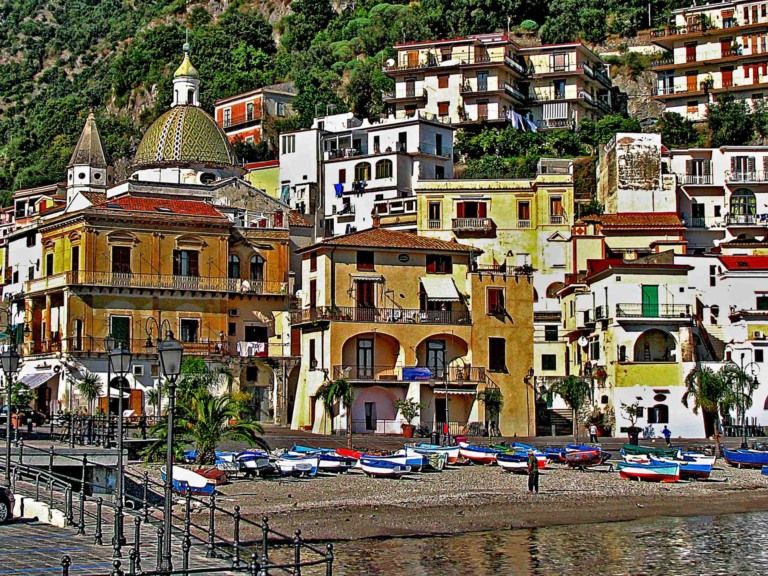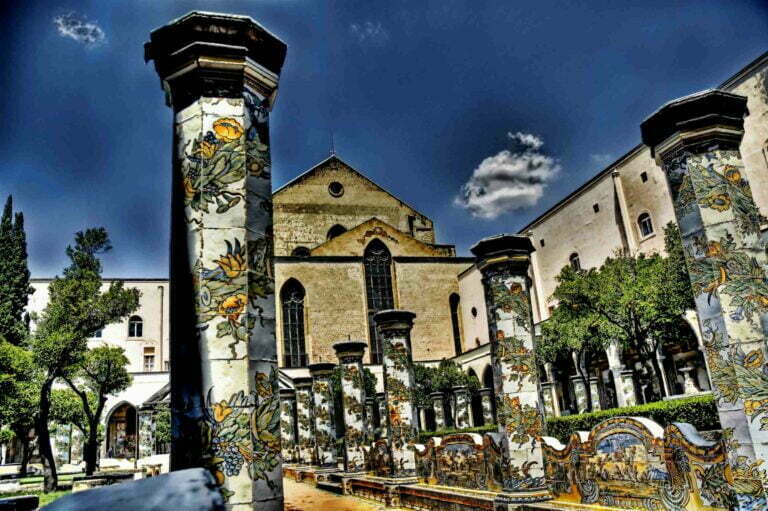The Costiera Amalfitana, which runs along the southern coast of the Sorrentine Peninsula within the Salerno province, can rightfully be described as a landscape of exceptional cultural significance, shaped by the remarkable interplay of nature and human endeavor. Its dramatic topography and historical evolution have given rise to extraordinary cultural and natural scenic values.
Costiera Amalfitana Italy
Here, nature remains untamed yet seamlessly interwoven with the fruits of human labor. The landscape is characterized by rocky terrain, lush woodlands, and aromatic maquis, punctuated by citrus groves and vineyards ingeniously cultivated wherever suitable terrain could be found.
Encompassing a vast expanse of 11,231 hectares, this expansive region spans 15 municipalities, agricultural lands, and three natural reserves. Inhabited since prehistoric times, as evidenced by the discovery of Palaeolithic and Mesolithic relics in Positano, it achieved Roman colony status in the 4th century and has been continuously settled since the early Middle Ages.
The Lattari Mountains on the southern side of the peninsula naturally demarcate this region, extending from the peaks of the Picentini Mountains to the Tyrrhenian Sea, effectively separating the Gulf of Naples from the Gulf of Salerno.
The World Heritage property encompasses four principal coastal areas (Amalfi, Atrani, Reginna Maior, and Reginna Minor) and several secondary areas (Positano, Praiano, Cetara, and Erchie), each graced with characterful villages like Scala, Tramonti, and Ravello, as well as the hamlets of Conca and Furore. Many of these historic centers thrived during the zenith of the Amalfi Sea Republic, resulting in a wealth of artistic and architectural treasures.
Some of these masterpieces reflect the intriguing fusion of Eastern and Western elements, exemplifying the “Arabic-Norman” style. The agricultural regions bear testimony to the resourcefulness of their inhabitants, who expertly adapted to the diverse terrains. They implemented terrace cultivation for vineyards and orchards in lower-lying areas and engaged in sheep farming in the elevated regions.
Amalfi Coast Facts
The Costiera Amalfitana, also known as the Amalfi Coast, is a stunning stretch of coastline located in the Campania region of southern Italy. Known for its dramatic cliffs, picturesque seaside villages, and Mediterranean beauty, the Amalfi Coast is a popular tourist destination. Here’s some information about this beautiful coastal region:
Costiera Amalfitana Amalfi Coast
1. Scenic Drive: The Amalfi Coast is famous for its scenic coastal road, the Amalfi Drive (SS163). This winding road offers breathtaking views of the coastline and is often considered one of the most beautiful drives in the world.
2. Amalfi: The town of Amalfi, which gives the coast its name, is a charming and historic place to visit. It has a stunning cathedral, lovely beaches, and a rich maritime history.
3. Positano: Positano is one of the most iconic villages on the Amalfi Coast, known for its pastel-colored houses cascading down the cliffs to the sea. It’s a favorite destination for travelers and photographers.
4. Ravello: Ravello is a peaceful hilltop town with beautiful gardens and some of the best panoramic views of the coastline. It’s famous for its annual music festival.
5. Praiano: A quieter and less crowded village, Praiano offers a more relaxed atmosphere while still providing stunning coastal views.
6. Furore: Furore is known for its dramatic fjord-like setting and the annual “Fjord of Furore” diving competition. It’s a unique spot for swimming and exploring.
7. Hiking: The Amalfi Coast offers excellent hiking opportunities. The “Path of the Gods” (Sentiero degli Dei) is a famous trail that provides spectacular vistas.
8. Cuisine: Enjoy delicious Mediterranean cuisine with an emphasis on fresh seafood, lemon-infused dishes, and local wines like Limoncello.
9. Beaches: The Amalfi Coast has both pebble and sandy beaches. Popular spots include Spiaggia Grande in Positano and the beach in Amalfi.
10. Boat Tours: Consider taking a boat tour along the coast to fully appreciate its beauty from the sea. You can also visit the famous Grotta dello Smeraldo (Emerald Grotto).
Amalfi Coast Travel Tips
- The best time to visit is during the spring (April to June) or early autumn (September to October) to avoid the summer crowds and high temperatures.
- The coastal roads can be narrow and winding, so if you’re driving, be prepared for adventurous driving.
- There are numerous boutique hotels, B&Bs, and luxury resorts along the coast, so plan your accommodations in advance, especially during peak seasons.
- The Amalfi Coast is well-connected by bus and ferry, making it possible to explore without a car.
The Amalfi Coast’s natural beauty, charming villages, and Mediterranean lifestyle make it a perfect destination for a romantic getaway, a relaxing holiday, or a memorable road trip along the Italian coastline.
Amalfi Coast History, Geography and Economy
The Amalfi Coast, located in the Campania region of southern Italy, is a region rich in history, stunning geography, and a diverse economy. Here’s an overview of its history, geography, and economy:
Amalfi Coast History
11. Ancient Origins: The history of the Amalfi Coast dates back to ancient times when it was inhabited by the Greeks and Romans. The town of Amalfi itself was a significant maritime republic during the Middle Ages.
12. Maritime Republic of Amalfi: Amalfi was one of the four major maritime republics in Italy, along with Venice, Genoa, and Pisa, during the 9th and 10th centuries. It played a crucial role in Mediterranean trade, influencing the region’s architecture and culture.
13. Norman Conquest: The Norman conquest of southern Italy in the 11th century led to the decline of the Amalfi Republic’s power.
14. Cultural Heritage: The Amalfi Coast has a rich cultural heritage, with influences from Greek, Roman, Arab, and Norman civilizations. This heritage is reflected in its architecture, art, and traditions.
Amalfi Coast Geography
15. Dramatic Landscape: The Amalfi Coast is renowned for its rugged and dramatic coastline. It stretches for about 50 kilometers (31 miles) along the southern edge of the Sorrentine Peninsula.
16. Cliffs and Fjords: The coast is characterized by steep limestone cliffs that plunge into the Mediterranean Sea. It features several fjord-like inlets, including the Fjord of Furore.
17. Hillside Villages: Perched on the cliffs, the coast is dotted with picturesque villages like Positano, Ravello, Amalfi, and Praiano. These villages are known for their charming, pastel-colored houses.
18. Natural Beauty: The region is part of the Sorrento Peninsula and is bordered by the Gulf of Salerno. It boasts lush vegetation, lemon groves, vineyards, and hiking trails.
19. UNESCO World Heritage Site: In 1997, the Amalfi Coast was designated as a UNESCO World Heritage Site for its exceptional cultural and natural value.
Amalfi Coast Economy
The Amalfi Coast is celebrated for its production of limoncello liqueur, crafted from the fragrant sfusato amalfitano lemons grown in terraced gardens that grace the entire coastline, flourishing from February to October.
In addition to this famed liqueur, Amalfi is renowned for its artisanal creation of bambagina, a robust handmade paper that embodies Italy’s ancient and cherished papermaking tradition. Historically employed for private writings, legal documents, and revenue stamps, bambagina holds a cherished place in Italy’s historical heritage.
Beyond these treasured offerings, the region is also known for its exceptional local products, including a unique variety of anchovy (known locally as alici) hailing from Cetara and the vibrant, handcrafted ceramics originating in Vietri, each piece a testament to the region’s rich artistic tradition.
20. Agriculture: The region is known for its agriculture, including the cultivation of lemons, olives, and grapes. Limoncello, a lemon liqueur, is a famous local product.
21. Fishing: Traditional fishing is still an important part of the economy in coastal towns.
22. Handicrafts: Local artisans produce ceramics, handmade paper, and other crafts that are popular with tourists.
23. Tourism: Tourism is the backbone of the Amalfi Coast’s economy. The stunning landscapes, historic villages, and Mediterranean climate attract millions of visitors annually. Tourism-related businesses, including hotels, restaurants, and shops, thrive here.
24. Maritime Activities: Yachting, boating, and water sports also contribute to the economy.
The Amalfi Coast’s history, geography, and economy have shaped it into a unique and enchanting destination, known for its cultural heritage, natural beauty, and vibrant tourist industry. It continues to draw travelers from around the world who seek to explore its coastal wonders and rich heritage.



